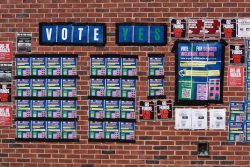When the MoMa began to display Colin Kaepernick’s jersey in its halls as a part of an exhibit entitled “Items: Is Fashion Modern?” the display, and the exhibit itself, showed that the museum understood something very important about the things we do and don’t choose to wear. Jay-Z understood this too, when he wore Kaepernick’s jersey on Saturday Night Live, and, although his message may have been different, so did the bar owner in Missouri who used the jersey as a doormat.
The student athletes at Georgetown understood this when they put tape over the Nike logos on their university- provided equipment. So, too, did the activists who sat-in at President John DeGioia’s office to protest the university’s relationship with Nike, ultimately leading to a victory for students and workers.
What all of these students, artists, and business owners know is this: Fashion, the clothes that we do and don’t choose to put on our bodies everyday, is inherently political. Sometimes this is overt, like using a Kaepernick jersey to show support for those struggling against police brutality, or wearing a “Make America Great Again” hat. Other times, the political implications are less obvious, reinforcing or exacerbating racial, economic, and gender hierarchies and inequalities.
In the realm of political discourse, fashion is an especially unique medium. It can be used to express oneself in a manner unlike other political displays, to say something without saying something. Fashion is also unique in that everyone must participate in it in one form or another. Everyone must dress themselves, and whether they are aware of it or not, the choices they make and the restrictions they have in those choices mean something.
With this in mind, this editorial board calls on Georgetown students and institutions to be more aware of the political nature of their dress.
On campus, a number of Georgetown clubs subscribe to what is often called a “pre-professional atmosphere.” While this provides many benefits to Georgetown students in their preparation for life after the Hilltop, it can also exclude students from these very clubs. Some clubs and on-campus jobs require business casual dress at minimum for their meetings and interviews, but it should be noted that this can bear a significant financial burden on students who wish to participate in these groups.
Any calls for greater diversity among the clubs that make up this campus must take a holistic approach to the problem, and this should include recognizing the effects of their dress code on prospective students. By being aware of the limitations that their dress codes can place on potential students, Georgetown’s institutions can create a more inclusive campus environment.
The problem of accessible dress codes goes beyond the institutions on this campus. Many of the internships and jobs that Georgetown students seek out and that can be so important to their future careers also include similar limitations, demanding students, often without paying them, wear business clothing to work. While this is not a call to end professional attire in the workplace, employers must be aware that the interns they hire are students, and as such, can be burdened by certain requirements for dress.
Individuals everywhere should consider the economic and environmental impacts of their clothes and the supply chains that bring them. The choices that Georgetown students make regarding their clothes represent more than just aesthetic or even practical decisions. The decisions on what, where, and how much to buy should represent value judgments regarding climate change, workers’ rights, and other political issues all over the world. When they fail to take such considerations into their purchases, students do themselves and countless others a disservice. It’s also vital to constantly evaluate the assumptions and judgments they have based on the clothing choices of others, and be aware of the various power dynamics that these can lead to and from which they are born.
Regardless of what it is that we do, value, or wear, we can’t hide from fashion. It is something that we must participate in every day, and to believe otherwise is naive at best and harmful at worst. The clothes we choose to put on and those that we ask and expect of others represent very real conflicts, tensions, and political issues. We at the Voice certainly aren’t here to tell you what to wear; that’s not our job, and we don’t want it to be. But we do want you to take a moment to think about what you’re saying when you get dressed or when you shop, and how those statements reflect the messages you want to represent you.





